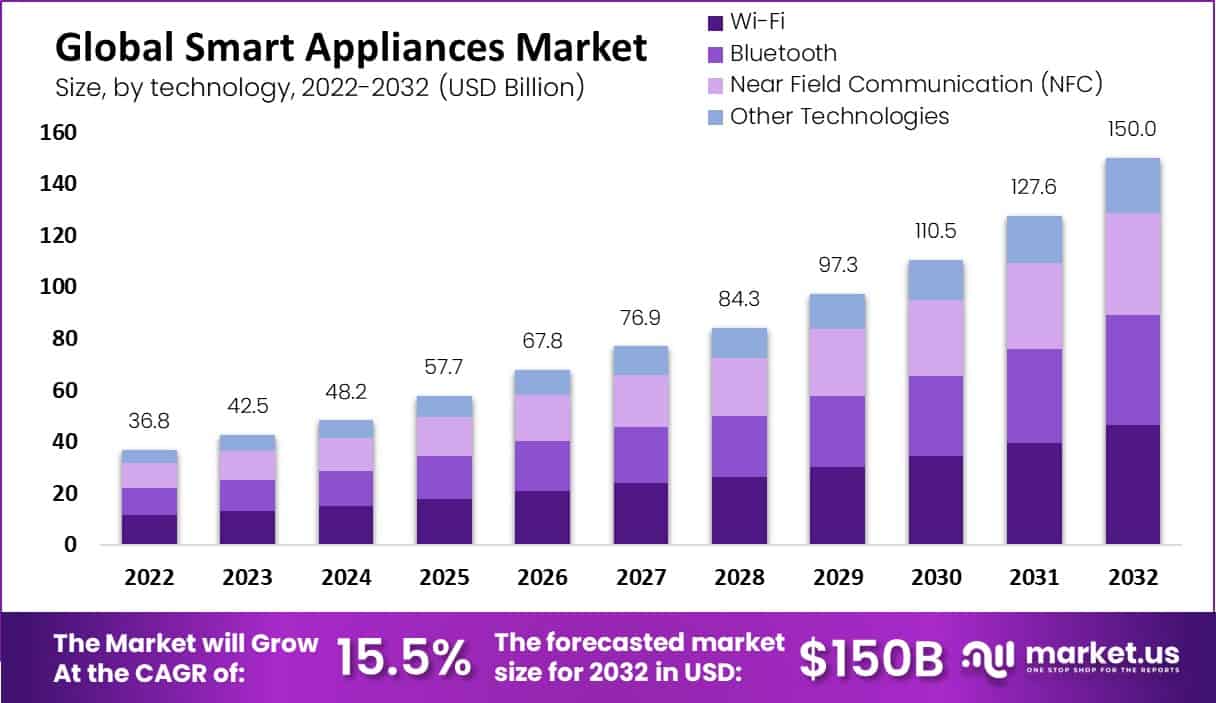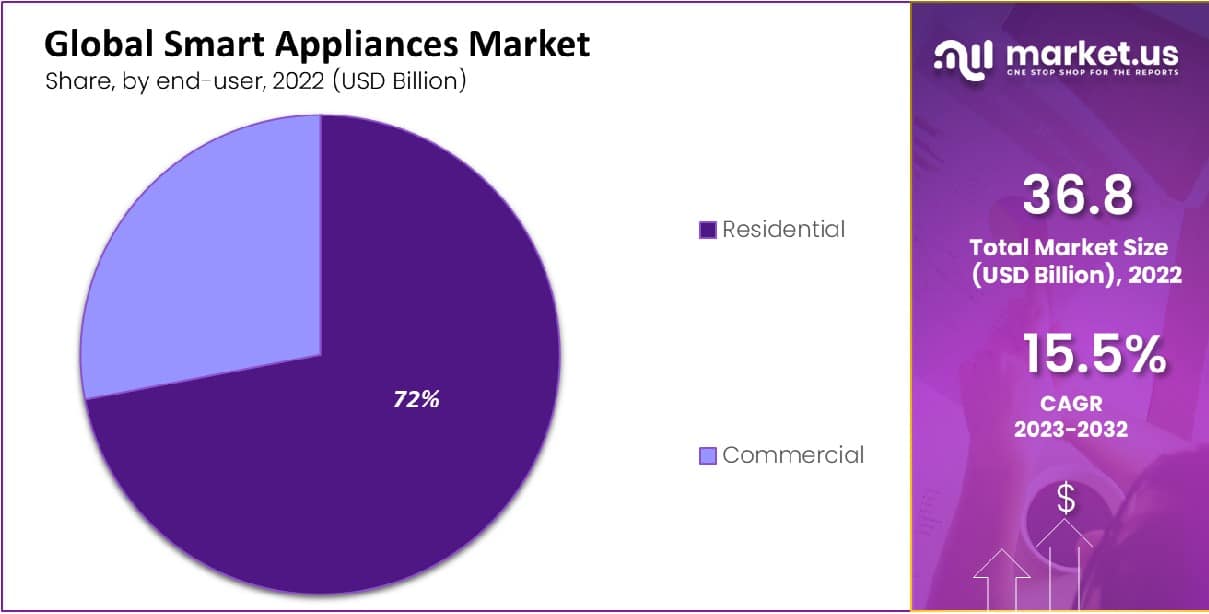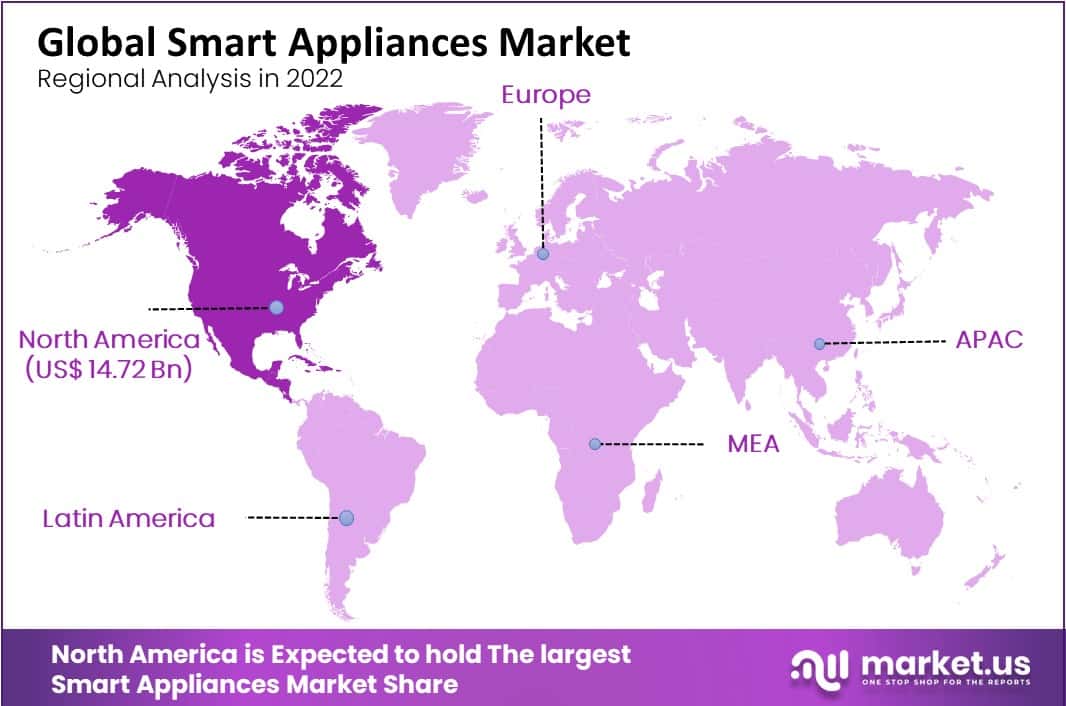Global Smart Appliances Market By Product (Smart Washing Machine, Smart Refrigerators, and Other Products), By Technology (Wi-Fi, Bluetooth, and Other Technologies), By Distribution Channel, By End-User, By Region and Companies - Industry Segment Outlook, Market Assessment, Competition Scenario, Trends, and Forecast 2023-2032
- Published date: Sep 2023
- Report ID: 29347
- Number of Pages: 254
- Format:
- keyboard_arrow_up
Quick Navigation
Report Overview
The Global Smart Appliances Market size is expected to be worth around USD 150 Billion by 2032 from USD 36.8 Billion in 2022, growing at a CAGR of 15.50% during the forecast period from 2023 to 2032.
Smart appliances are those connected to the internet or other networks enabling remote control as well as automated operation. These home devices assist with decision-making, solve common issues, and keep life healthy and secure.
Smart appliances can result in significant cost savings. Some examples of such appliances include refrigerators, ovens, washing machines, thermostats, and lighting systems that are connected to the Internet. Smart appliances can be operated using a smartphone, tablet, voice commands, or even artificial intelligence assistants like Alexa or Google Assistant.
Smart appliances offer convenience, energy efficiency, and improved functionality making them increasingly popular in present homes owing to the rising digitalization and use of smartphones and tablets. Smart appliances give users access to everyday home appliance controls at their fingertips with ease.

Driving Factors
Increasing Popularity of Wireless Connectivity Solutions
Smart appliances provide convenience and ease of use. With the ability to connect to the internet and be controlled using wireless solutions. Wireless solutions not only help reduce the use of wires but also allow for flexibility. Smart appliances are energy efficient and can be programmed to set the timer or shut down automatically. Many consumers are interested in reducing their energy consumption and lowering their utility bills by using smart appliances.
Technology has made it possible for smart appliances to be more efficient, reliable, and user-friendly. Smart appliances are now more affordable and accessible owing to these technological advances. Smart appliances can now be connected to other devices and systems within the home due to the Internet of Things. This allows users to control multiple devices and appliances from one app which makes it easier to manage their homes.
Restraining Factors
High Cost and Data Breach Risk becomes Major Restraints
One of the major obstacles in the smart appliances market is their high cost. Smart appliances tend to be more costly than traditional options, making them unattainable for some consumers. Furthermore, compatibility with existing home systems and appliances may be an issue as many require certain levels of connectivity or integration with other devices, something which may prove challenging if your house does not already possess this technology.
Smart appliances can pose a cybersecurity risk if not properly secured. As more devices become connected to the internet, concerns over cyber-attacks and data breaches have grown. Furthermore, most smart appliance control is done through smartphone apps developed by companies; companies typically capture consumer data through these applications which further increases privacy concerns among users. Thus, privacy concerns could potentially limit growth in the smart appliance market.
Growth Opportunities
Technological Advancement such as IoT, and AI will be in Growing Demand
The smart appliances market offers companies an exciting chance to capitalize on the growing demand for connected devices and the Internet of Things. Smart appliances are home electronics that can be controlled remotely through a smartphone or other connected device enabling them to perform tasks automatically.
Companies developing these products are working towards infusing artificial intelligence (AI) into them for increased customization and convenience for consumers. The global smart appliances market is forecast to experience significant growth over the coming years, driven by rising demand for energy-saving appliances, growing adoption of connected homes, and rising usage of connected devices.
Smart appliances provide several advantages, such as improved energy efficiency, convenience, and enhanced security. Furthermore, companies can make additional revenues through value-added services like remote monitoring, predictive maintenance, and personalized recommendations.
Latest Trends
Integration of Voice Assistants such as Amazon Alexa and Google Assistant
Smart appliances are becoming more and more connected enabling users to control and monitor their appliances from any smartphone or other connected device. Connectivity is fueling the growth of the smart home market and opening up new applications and services.
Voice assistants such as Amazon Alexa and Google Assistant are becoming more and more integrated into smart appliances allowing users to operate these items using simple voice commands. This trend is making it simpler for consumers to interact with their appliances, raising the adoption of smart home technology.
Smart appliances are designed to optimize energy usage and reduce waste, giving cost savings to consumers while helping reduce carbon emissions. Smart appliances are becoming more customizable and personalized, offering features such as user profiles and tailored recommendations. This trend is driven by a desire for an enhanced user experience and is expected to continue evolving with technological advances.
Product Analysis
The Smart Washing Machine Product Segment is Dominant
Based on product, the market for smart appliances is segmented into smart washing machines, smart refrigerators, smart air purifiers, smart TVs, and other products. Among these types, the smart washing machine segment is the most lucrative in the global smart appliances market, with a projected CAGR of 8.6%.
The total revenue share of the smart washing machine product segment is 31% in 2022. Smart washing machines are technologically advanced appliances with features beyond those found in traditional washers. They can be connected to the internet and controlled using a smartphone, tablet, or other compatible devices; they may even be integrated with other smart home systems like thermostats or lighting controls for an entirely automated and connected environment.
Smart washing machines offer convenience, energy efficiency, and enhanced functionality – making them increasingly popular options for modern homes due to seamless internet access and the growing number of smartphone users worldwide.
Technology Analysis
Wi-Fi Technology is Dominant in the Global Smart Appliances Market
By technology, the market is further divided into Wi-Fi, Bluetooth, near-field communication (NFC), and other technologies. Wi-Fi technology is estimated to be the most lucrative segment in the global smart appliances market, with a market share of 30% and a projected CAGR of 14.4%, in 2022.
Most smart appliances rely on Wi-Fi to connect to the internet and communicate with other devices, enabling you to control them remotely via a smartphone app or other compatible devices. Wireless communication plays an integral role in monitoring home appliances from distant locations to save electricity consumption. While Wi-Fi is the most common connectivity technology used in smart appliances other technologies such as Bluetooth or Near Field Communication (NFC) may also be utilized.
Distribution Channel Analysis
The Offline Distribution Channel is Dominant
Based on distribution channels, the market is segmented into offline channels and online channels. Among these channels, the offline distribution channel is estimated to be the most lucrative segment in the global smart appliances market, with a market share of 64.8% and a projected CAGR of 14.6%, in 2022.
Smart appliances can be purchased through offline channels like appliance stores, electronics stores, and home improvement stores. This gives customers a closer look at the products, helping to guarantee their quality and specifications. Customers have the opportunity to touch and feel the appliances before making a purchase decision and may receive assistance from knowledgeable sales personnel as well.
End-User Analysis
The Residential Segment is Dominant
Based on end-users, the market is segmented into residential and commercial. Among these end-users, the residential segment is estimated to be the most lucrative segment in the global smart appliances market, with the largest revenue share of 72% and a projected CAGR of 13.4% during the forecast period.
Residential demand for smart appliances has been growing rapidly in recent years as more consumers strive to make their homes more connected and efficient.
Smart appliances offer greater convenience by enabling homeowners to control their appliances remotely with a smartphone or other device also they are designed to be energy efficient compared to traditional models. Furthermore, rising internet penetration levels and easy accessibility of these smart products are creating an enabling environment for market expansion.

Key Market Segments:
Based on Product
- Smart Washing Machine
- Smart Refrigerators
- Smart Air Purifiers
- Smart TV
- Other Products
Based on Technology
- Wi-Fi
- Bluetooth
- Near Field Communication (NFC)
- Other Technologies
Based on the Distribution Channel
- Offline
- Online
Based on End-User
- Residential
- Commercial
COVID-19 Impact Analysis
The COVID-19 pandemic had a significant effect on the smart appliances market both in terms of demand disruptions and supply chain interruptions. The crisis has disrupted global supply chains causing delays in the production and delivery of these innovative items. Due to these developments, manufacturers and retailers have faced increased costs and longer lead times.
Due to lockdowns and work-from-home arrangements, more people are staying at home. To accommodate this trend, smart appliances like refrigerators, washing machines, and air purifiers have become increasingly popular. This trend is expected to persist as consumers prioritize convenience and safety in their homes.
Businesses have seen an improvement in remodeling projects during the pandemic. Brands are paying closer attention to their target demographic as the market expands, altering their marketing strategies accordingly to attract customers.
Regional Analysis
North America is the Dominant Region in the Global Smart Appliances Market
North America is anticipated to be the most dominant region in the global smart appliances market with the largest market share of 40% and is projected to register a CAGR of 17.2% during the forecast period. Due to increasing internet penetration and technological developments in emerging economies like Canada and the U.S.
As a result, smart appliances have become growingly in demand due to product developments and advances in wireless communication technology. The U.S. market has experienced an annualized rise in smart devices and this trend appears to be set for continued expansion.
Europe is witnessing a significant surge in small startups and higher investments from countries such as France, the U.K., and Germany due to the increasing need for security monitoring solutions. These factors will continue to shape the regional market ultimately driving global smart home appliance demand and size upwards.

Key Regions and Countries Covered in this Report:
- North America
- The US
- Canada
- Mexico
- Western Europe
- Germany
- France
- The UK
- Spain
- Italy
- Portugal
- Ireland
- Austria
- Switzerland
- Benelux
- Nordic
- Rest of Western Europe
- Eastern Europe
- Russia
- Poland
- The Czech Republic
- Greece
- Rest of Eastern Europe
- APAC
- China
- Japan
- South Korea
- India
- Australia & New Zealand
- Indonesia
- Malaysia
- Philippines
- Singapore
- Thailand
- Vietnam
- Rest of APAC
- Latin America
- Brazil
- Colombia
- Chile
- Argentina
- Costa Rica
- Rest of Latin America
- Middle East & Africa
- Algeria
- Egypt
- Israel
- Kuwait
- Nigeria
- Saudi Arabia
- South Africa
- Turkey
- United Arab Emirates
- Rest of MEA
Emerging key players are employing various strategic tactics to expand their businesses into foreign markets. Companies are investing heavily in research and development to release cutting-edge smart appliances that meet the increasing demand for this technology.
To boost global revenues smart appliance market companies are employing merger and acquisition tactics. Furthermore, they’re expanding product portfolios with advanced features like voice recognition, AI-powered controls, and IoT connectivity to enhance customer experience and gain a competitive edge within the market.
Market Key Players:
Listed below are some of the most prominent smart appliances industry players.
- Samsung Electronics Co. Ltd.
- Whirlpool Corp.
- LG Electronics
- Haier Group
- Panasonic Corp.
- BSH Hausgerate GmbH
- Electrolux AB
- Koninklijke Philips N.V.
- GE Appliances
- Xiaomi Corp.
- Other Key Players
Recent Developments:
- ABB Group, a leader in automation and power solutions, joined Samsung as an official partner in April 2022. This collaboration aimed to hasten the adoption of SmartThings into more homes and buildings while also helping users reduce costs and have a greater environmental impact.
- In December 2021, Panasonic and Swidget, a manufacturer of modular smart home devices, formed a partnership to create an end-to-end smart home ventilation system. With this solution, homeowners will have full control over their indoor air quality and be able to make adjustments in real time.
Report Scope:
Report Features Description Market Value (2022) USD 36.8 Bn Forecast Revenue (2032) USD 150 Bn CAGR (2023-2032) 15.5% Base Year for Estimation 2022 Historic Period 2016-2022 Forecast Period 2023-2032 Report Coverage Revenue Forecast, Market Dynamics, COVID-19 Impact, Competitive Landscape, Recent Developments Segments Covered By Product (Smart Washing Machines, Smart Refrigerators, Smart Air Purifiers, Smart TVs, and Other Products), By Technology (Wi-Fi, Bluetooth, Near Field Communication (NFC), and Other Technologies), By Distribution Channel (Online and Offline), By End-User (Residential and Commercial) Regional Analysis North America – The US, Canada, & Mexico; Western Europe – Germany, France, The UK, Spain, Italy, Portugal, Ireland, Austria, Switzerland, Benelux, Nordic, & Rest of Western Europe; Eastern Europe – Russia, Poland, The Czech Republic, Greece, & Rest of Eastern Europe; APAC – China, Japan, South Korea, India, Australia & New Zealand, Indonesia, Malaysia, Philippines, Singapore, Thailand, Vietnam, & Rest of APAC; Latin America – Brazil, Colombia, Chile, Argentina, Costa Rica, & Rest of Latin America; the Middle East & Africa – Algeria, Egypt, Israel, Kuwait, Nigeria, Saudi Arabia, South Africa, Turkey, United Arab Emirates, & Rest of MEA Competitive Landscape Samsung Electronics Co. Ltd., Whirlpool Corp., LG Electronics, Haier Group, Panasonic Corp., BSH Hausgerate GmbH, Electrolux AB, Koninklijke Philips N.V., GE Appliances, Xiaomi Corp., Other Key Players Customization Scope Customization for segments, region/country-level will be provided. Moreover, additional customization can be done based on the requirements. Purchase Options We have three licenses to opt for Single User License, Multi-User License (Up to 5 Users), Corporate Use License (Unlimited User and Printable PDF) Frequently Asked Questions (FAQ)
What is the size of the Smart Appliances Market in 2022?The Smart Appliances Market size was estimated to be USD 36.8 billion in 2022.
What is the projected CAGR at which the Smart Appliances Market is expected to grow at?The Smart Appliances Market is expected to grow at a CAGR of 15.5% (2023-2032).
List the key industry players of the Smart Appliances Market?Samsung Electronics Co. Ltd., Whirlpool Corp., LG Electronics, Haier Group, Panasonic Corp., BSH Hausgerate GmbH, Electrolux AB, Koninklijke Philips N.V., GE Appliances, Xiaomi Corp., Other Key Playersengaged in the Smart Appliances Market.
Which region is more appealing for vendors employed in the Smart Appliances Market?North America is anticipated to be the most dominant region in the global smart appliances market with the largest market share of 40% and is projected to register a CAGR of 17.2% during the forecast period.

- Samsung Electronics Co. Ltd.
- Whirlpool Corp.
- LG Electronics
- Haier Group
- Panasonic Corp.
- BSH Hausgerate GmbH
- Electrolux AB Company Profile
- Koninklijke Philips N.V.
- GE Appliances
- Xiaomi Corp.
- Other Key Players
- settingsSettings
Our Clients
| Single User $4,599 $3,499 USD / per unit save 24% | Multi User $5,999 $4,299 USD / per unit save 28% | Corporate User $7,299 $4,999 USD / per unit save 32% | |
|---|---|---|---|
| e-Access | |||
| Report Library Access | |||
| Data Set (Excel) | |||
| Company Profile Library Access | |||
| Interactive Dashboard | |||
| Free Custumization | No | up to 10 hrs work | up to 30 hrs work |
| Accessibility | 1 User | 2-5 User | Unlimited |
| Analyst Support | up to 20 hrs | up to 40 hrs | up to 50 hrs |
| Benefit | Up to 20% off on next purchase | Up to 25% off on next purchase | Up to 30% off on next purchase |
| Buy Now ($ 3,499) | Buy Now ($ 4,299) | Buy Now ($ 4,999) |












